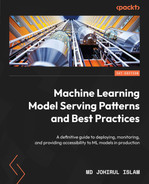Table of Contents
Preface
Part 1: Introduction to Model Serving
1
Introducing Model Serving
Technical requirements
What is serving?
What are models?
What is model serving?
Understanding the importance of model serving
Using existing tools to serve models
Summary
2
Introducing Model Serving Patterns
Design patterns in software engineering
Understanding the value of model serving patterns
ML serving patterns
Serving philosophy patterns
Patterns of serving approaches
Summary
Further reading
Part 2: Patterns and Best Practices of Model Serving
3
Stateless Model Serving
Technical requirements
Understanding stateful and stateless functions
Stateless functions
Stateful functions
Extracting states from stateful functions
Using stateful functions
States in machine learning models
Using input data as states
Mitigating the impact of states from the ML model
Summary
4
Continuous Model Evaluation
Technical requirements
Introducing continuous model evaluation
What to monitor in model evaluation
Challenges of continuous model evaluation
The necessity of continuous model evaluation
Monitoring errors
Deciding on retraining
Enhancing serving resources
Understanding business impact
Common metrics for training and monitoring
Continuous model evaluation use cases
Evaluating a model continuously
Collecting the ground truth
Plotting metrics on a dashboard
Selecting the threshold
Setting a notification for performance drops
Monitoring model performance when predicting rare classes
Summary
Further reading
5
Keyed Prediction
Technical requirements
Introducing keyed prediction
Exploring keyed prediction use cases
Multi-threaded programming
Multiple instances of the model running asynchronously
Why the keyed prediction model is needed
Exploring techniques for keyed prediction
Passing keys with features from the clients
Removing keys before the prediction
Tagging predictions with keys
Creating keys
Summary
Further reading
6
Batch Model Serving
Technical requirements
Introducing batch model serving
What is batch model serving?
Different types of batch model serving
Manual triggers
Automatic periodic triggers
Using continuous model evaluation to retrain
Serving for offline inference
Serving for on-demand inference
Example scenarios of batch model serving
Case 1 – recommendation
Case 2 – sentiment analysis
Techniques in batch model serving
Setting up a periodic batch update
Storing the predictions in a persistent store
Pulling predictions by the server application
Limitations of batch serving
Summary
Further reading
7
Online Learning Model Serving
Technical requirements
Introducing online model serving
Serving requests
Use cases for online model serving
Case 1 – recommending the nearest emergency center during a pandemic
Case 2 – predicting the favorite soccer team in a tournament
Case 3 – predicting the path of a hurricane or storm
Case 4 – predicting the estimated delivery time of delivery trucks
Challenges in online model serving
Challenges in using newly arrived data for training
Underperforming of the model after online training
Overfitting and class imbalance
Increasing of latency
Handling concurrent requests
Implementing online model serving
Summary
Further reading
8
Two-Phase Model Serving
Technical requirements
Introducing two-phase model serving
Exploring two-phase model serving techniques
Quantized phase one model
Training and saving an MNIST model
Full integer quantization of the model and saving the converted model
Comparing the size and accuracy of the models
Separately trained phase one model with reduced features
Separately trained different models
Use cases of two-phase model serving
Case 4 – route planners
Summary
Further reading
9
Pipeline Pattern Model Serving
Technical requirements
Introducing the pipeline pattern
A DAG
Stages of the machine learning pipeline
Introducing Apache Airflow
Getting started with Apache Airflow
Creating and starting a pipeline using Apache Airflow
Demonstrating a machine learning pipeline using Airflow
Advantages and disadvantages of the pipeline pattern
Summary
Further reading
10
Ensemble Model Serving Pattern
Technical requirements
Introducing the ensemble pattern
Using ensemble pattern techniques
Model update
Aggregation
Model selection
Combining responses
End-to-end dummy example of serving the model
Summary
11
Business Logic Pattern
Technical requirements
Introducing the business logic pattern
Type of business logic
Technical approaches to business logic in model serving
Data validation
Feature transformation
Prediction post-processing
Summary
Part 3: Introduction to Tools for Model Serving
12
Exploring TensorFlow Serving
Technical requirements
Introducing TensorFlow Serving
Servable
Loader
Source
Aspired versions
Manager
Using TensorFlow Serving to serve models
TensorFlow Serving with Docker
Using advanced model configurations
Summary
Further reading
13
Using Ray Serve
Technical requirements
Introducing Ray Serve
Deployment
ServeHandle
Ingress deployment
Deployment graph
Using Ray Serve to serve a model
Using the ensemble pattern in Ray Serve
Using Ray Serve with the pipeline pattern
Summary
Further reading
14
Using BentoML
Technical requirements
Introducing BentoML
Preparing models
Services and APIs
Bento
Using BentoML to serve a model
Summary
Further reading
Part 4: Exploring Cloud Solutions
15
Serving ML Models using a Fully Managed AWS Sagemaker Cloud Solution
Technical requirements
Introducing Amazon SageMaker
Amazon SageMaker features
Using Amazon SageMaker to serve a model
Creating a notebook in Amazon SageMaker
Serving the model using Amazon SageMaker
Summary
Index
Other Books You May Enjoy
..................Content has been hidden....................
You can't read the all page of ebook, please click here login for view all page.
